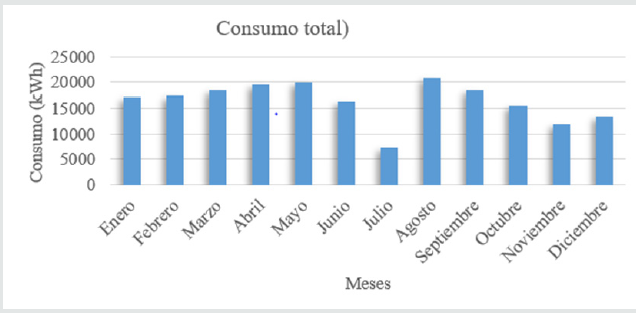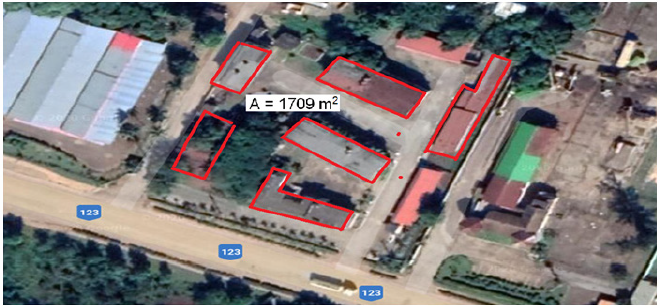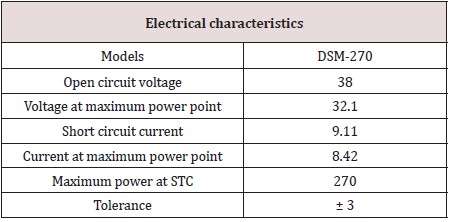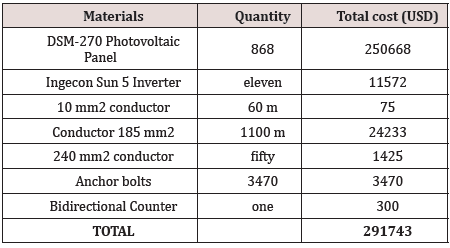
Lupine Publishers Group
Lupine Publishers
Menu
ISSN: 2643-6736
Research article(ISSN: 2643-6736) 
Technical Economic Analysis of the Installation of A Photovoltaic System in the Municipality of Moa Volume 2 - Issue 5
Alvaro Laurencio Pérez1*, Igor R Pérez Maliuk2, Rodney Martínez Rojas3 and Luis Leandro Hernández Sánchez3
- 1Department of Electrical Engineering of the University of Moa, Cuba
- 2Holguín Electric Company, Cuba
- 3Department of Mechanical Engineering of the University of Moa, Cuba
Received: July 22, 2020; Published: July 29, 2020
Corresponding author: Alvaro Laurencio Pérez, Department of Electrical Engineering of the University of Moa, DrC Antonio Núñez Jiménez, Cuba
DOI: 10.32474/ARME.2020.02.000146
Abstract
In this work, an economic technical analysis of the implementation of a photovoltaic system to supply a group of 6 offices in the town of Moa is carried out. The study is carried out with the support of the calculation tool PVSyst and using the criteria Net Present Value, Internal Rate of Return and Recovery Period for the economic evaluation. The results indicated that the installation can generate 391,419MWh/a. The Net Present Value resulted from321423.54 USD, while the Internal Rate of Return was 14.64%, higher than the imposed rate of 12%. On the other hand, the Recovery Period of the investment was 6.09 years. The economic evaluation criteria indicate that the variant can be accepted, since it offers income during its useful life.
Keywords: Photovoltaic system; PVSyst; Net present value; Internal rate of return; Recovery period
Introduction
Photovoltaic systems installed on roofs are increasingly
common, since they not only stop occupying extensions that could
be part of some productive, cultural process, etc. But also guarantee
the supply of energy in the same place where it is consumed, which
contributes to the minimization of distribution losses. On the
other hand, several works demonstrate that in the region of the
Americas there is good potential for the exploitation of renewable
energy resources, specifically the exploitation of energy from the
Sun using photovoltaic systems [1-3]. In the country, the energy
context is directed to the development of renewable energy
sources, including photovoltaic solar energy. Within the guidelines
of the economic and social policy approved in the VI congress, the
Communist Party of Cuba refers to the use of alternative energy
sources in guideline 247, in which it is proposed to promote the
use of different renewable sources energy, prioritizing those that
have the greatest economic effect. This contributes to the fact that
several researchers are based on the potential of the country in
terms of the use of photovoltaic solar energy [4,5].
In order to comply with the country’s energy policy, the need
arises to carry out studies related to the issue of photovoltaic solar
energy in available spaces, in this case, taking advantage of the roof
of buildings.
The literature consulted on the subject is very varied. Some
authors consider the technical aspect in the dimensioning of the
installation, and that most of them rely on computational calculation
tools such as HOMER, RETScreen, PVSyst, among others, the latter
being one of the most widely used [5,6]. On the other hand, the
economic profit is based fundamentally on the criteria of the Net
Present Value (NPV) and the Recovery Period (PR) [6-8]. However,
the Internal Rate of Return (IRR) criterion allows us to know the
slack that exists with respect to the real value of the interest rate.
In this work, an economic technical analysis is carried out for the
installation of a photovoltaic system connected to the network, on
rooftops, in the town of Moa. The PVSyst calculation tool is used
to estimate the energy generated and the arrangement of panels. Likewise, the economic evaluation is based on the criteria of VAN,
TIR and PR.
Materials and Methods
Case study
The municipality of Moa is located in the northwest portion of the Holguín province with coordinates 20,390 North latitude and 74,560 West longitude. The location is proposed to be located on the roofs of 6 offices, for a total area of 1709m2, as shown in Figure 1.
For the year 2019, the total consumption of the offices was 196.66MWh, distributed by months as shown in Figure 2.
Note that the months of greatest consumption are May and August, mainly associated with the local weather conditions and the continuity of work outside the working day.
Photovoltaic modules
The study is carried out considering DSM-270 series modules manufactured in the Pinar del Río Province, which is made up of 60 solar cells of 156.75mm x 156.75mm format, connected in series. Its characteristics are shown in Table 1.
PVSyst software
The PVSyst software is a tool used to model the behavior of photovoltaic installations; enables the study, simulation and analysis of data from photovoltaic systems. With this software, facilities can be dimensioned, taking into account the solar radiation that it would receive depending on its location thanks to its meteorological database, and which takes into account the casting of shadows thanks to the simulation of the movement of the Sun during the day. This is one of the most widely used tools for energy evaluation studies of photovoltaic systems due to the relative simplicity with which it can be manipulated [5,6].
Economic evaluation
To perform the analysis from an economic point of view, the Net Present Value, Internal Rate of Return and Recovery Period are considered. The NPV measures in current money the degree of greater wealth that the investor will have in the future if he undertakes the project, so the result of the same must be positive in order for income to be generated [3,7,8]. Serving [8], the NPV can be calculated using the expression.

Where I0 is the initial investment, in USD, the FCn is the cash flow of the year n in USD and k is the discount or interest rate in percent.
The IRR method consists of an iteration process where two NPVs are searched, one positive and the other negative, whose values are as close to zero as possible. Once the positive and negative values have been found with their corresponding interest rate, the equation is applied (2), as proposed by [9].

Where kp and kn are the interest rates at which the positive and negative values are obtained, the NPV, respectively, expressed in percent. While VANp and VANn are the positive and negative Net Present Value, respectively in USD. The payback period marks the time, in years, that the project costs are supplemented by the benefits achieved, the mathematical equation of which is described in (3), considering constant cash flows.

Where FC is the annual cash flow, in USD.
Results
Arrangement of the whole and generated energy
For the simulation, an inclination angle of 180 is taken into account, the results of which determined that a total of 868 photovoltaic modules can be located in the 6 offices for an installed power of approximately 234.36 kW. In addition, a monthly load survey is carried out for each office and their total consumption is estimated. Figure 3 represents the total consumption of the premises, symbolized by the blue line and the energy produced by the plant, represented by the orange line, according to the results offered by the software.
Figure 2: Comparison of the energy produced by the plant and the consumption of the premises
Based on the results offered by the software, the energy generated per year is equivalent to 391,419 MWh.

Economic evaluation
The economic evaluation is carried out based on the initial investment of the study, which considers the essential elements for the implementation of the photovoltaic system. Table 2 shows the elements considered in this investigation for the commissioning of the site.
From Table 2 it follows that the initial investment is 807,743 USD. Taking into account that the energy generated by the installation is 391,419MWh/a, it generates cash flows equivalent to 58712.85USD/a, assuming an energy cost of 150USD/MWh generated. Table 3 shows the results obtained from the economic evaluation study.
To calculate the NPV, an interest rate of 12% is considered, used to study projects in the country. The VAN of 321423.54 indicates the income that could be obtained with the commissioning of the installation for the 25 years of its useful life that the manufacturer guarantees. On the other hand, the IRR of 14.64% is higher than the interest rate (12%) used in the study, so the work can be accepted. The time in which the investment is recovered is 6.09 years, a relatively short value compared to the 25-year life of the installation.
Conclusion
a) The installation guarantees an energy of 391,419MWh/a
per year with 868 connected modules.
b) The commissioning of the installation requires an initial
investment of 291,743 USD, which, taking into account the
economic results, recovers in approximately 6 years.
c) The economic evaluation criteria indicate that the variant
can be accepted, since it offers income during its useful life.
References
- David JM, Escobar AM, Hincapie R(2009) Description and analysis of the photovoltaic effect in the region. Scientia Et Technica.
- Ospino AJC (2010) Analysis of the solar energy potential in the Caribbean region for the design of a photovoltaic system. Inge-CUC 6.
- Rodríguez AKM, Cadena Á IM,Aristizábal AJC (2015) Design of photovoltaic solar energy systems for residential users in Chía, Cundinamarca 5: 55-65.
- Guzmán MV, Soto CRC (2017) Procedure for the installation of a photovoltaic system on roofs in the corporation Cuba SA. Sugar Center44.
- Osorio Laurencio L, Montero Laurencio R (2016) Energy analysis of a photovoltaic system integrated into a horizontal flat roof. Energy Engineering37(1): 45-54.
- García JEG, Sepúlveda SBM, Ferreira JJ (2018) Technical-economic viability of a photovoltaic system in a water treatment plant. INGE CUC14(1): 41-51.
- González CL, Torres J (2018) Economic technical study of solar panels interconnected to the distribution network. Iberoamerican Science Magazine5: 95-105.
- Salas YR, Gómez HB (2018) Technical and economic design of a photovoltaic solar test bench for the generation of electrical energy in isolation. Prospective16: 82-88.
- Taco D, Gutiérrez M (2018) Valuation of investments in unconventional projects-Internal rate of return versus internal rate of return modified. INNOVATIVE3: 126-133.

Top Editors
-

Mark E Smith
Bio chemistry
University of Texas Medical Branch, USA -

Lawrence A Presley
Department of Criminal Justice
Liberty University, USA -

Thomas W Miller
Department of Psychiatry
University of Kentucky, USA -

Gjumrakch Aliev
Department of Medicine
Gally International Biomedical Research & Consulting LLC, USA -

Christopher Bryant
Department of Urbanisation and Agricultural
Montreal university, USA -

Robert William Frare
Oral & Maxillofacial Pathology
New York University, USA -

Rudolph Modesto Navari
Gastroenterology and Hepatology
University of Alabama, UK -

Andrew Hague
Department of Medicine
Universities of Bradford, UK -

George Gregory Buttigieg
Maltese College of Obstetrics and Gynaecology, Europe -

Chen-Hsiung Yeh
Oncology
Circulogene Theranostics, England -
.png)
Emilio Bucio-Carrillo
Radiation Chemistry
National University of Mexico, USA -
.jpg)
Casey J Grenier
Analytical Chemistry
Wentworth Institute of Technology, USA -
Hany Atalah
Minimally Invasive Surgery
Mercer University school of Medicine, USA -

Abu-Hussein Muhamad
Pediatric Dentistry
University of Athens , Greece

The annual scholar awards from Lupine Publishers honor a selected number Read More...









